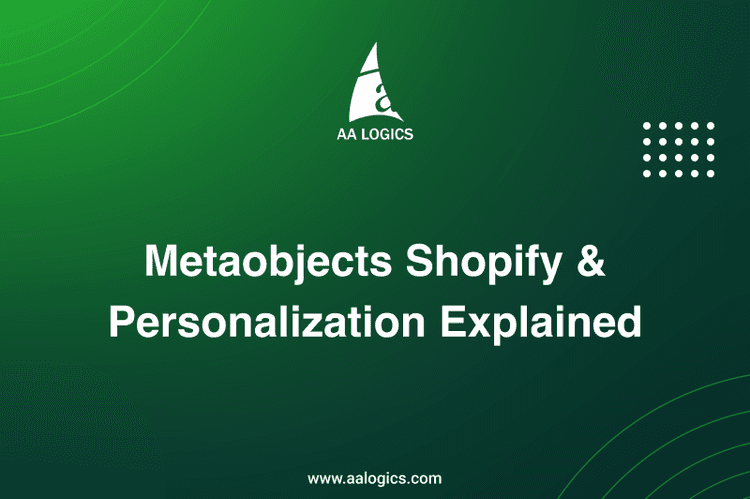Headless Commerce 2025: Shopify Hydrogen vs Magento PWA
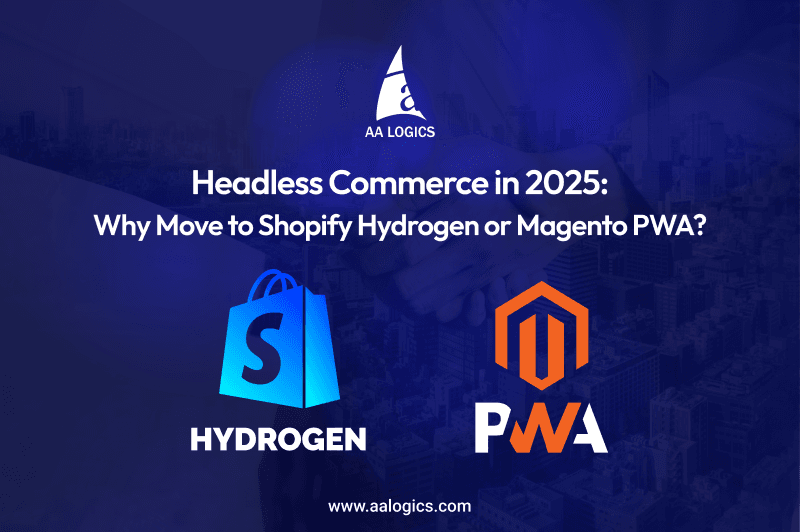
Headless Commerce in 2025: Why Move to Shopify Hydrogen or Magento PWA?
In 2025, “fast” is table stakes. Customers expect near-instant loading, seamless mobile experiences and highly personalised journeys across channels. Headless commerce — separating your storefront (frontend) from your commerce engine (backend) — gives you that speed and flexibility without rebuilding everything from scratch.
This guide is for store owners, startups and decision-makers who are researching or ready to migrate. It compares Shopify Hydrogen and Magento PWA, shows likely ROI and costs, provides a business-friendly migration checklist, and shares AALogics case studies so you can see real outcomes.
What Is Headless Commerce in Plain Business Terms?
Headless commerce decouples the customer-facing interface from the backend systems that power products, orders and inventory. Think of it like a plug-and-play setup: the backend provides the data and business rules, and the frontend renders the user experience via APIs.
For business leaders that means:
- Faster pages and better Core Web Vitals (which improves SEO and conversion).
- The same backend powering multiple channels — web, mobile PWA, kiosks and voice.
- Faster iteration: you can redesign the front end without replatforming the backend.
Headless is no longer experimental. In 2025 it’s a mainstream choice for brands that want flexibility, speed and future-proofing. If you want a deep dive into headless commerce concepts, Shopify’s official headless commerce guide is a great resource.
Shopify Hydrogen: Quick Overview, Pros & Cons for Businesses
What is Shopify Hydrogen:
Shopify Hydrogen is Shopify’s React-based toolkit for building custom storefronts that use Shopify’s Storefront APIs. It pairs well with Shopify’s hosted infrastructure.
Pros For Business Owners
- Fast time to market for merchants already on Shopify.
- Managed hosting option reduces DevOps overhead.
- Deep integration with Shopify Payments, apps and checkout flows.
- Works well for DTC and SMBs that prioritise speed and simplicity.
Cons to Consider Before Choosing Shopify Hydrogen
- Tied to Shopify’s backend and pricing model (Shopify Plus for enterprise needs).
- Some enterprise features may still require custom work or apps.
- The developer resource market for Hydrogen is growing but more niche than general web dev.
Who Should Consider Shopify Hydrogen:
DTC brands, fast-growing SMBs, and retailers who want modern frontends plus the convenience of Shopify’s managed services.
Magento PWA: Quick Overview, Pros & Cons for Businesses
What is Magento PWA:
Magento PWA (or PWA approaches used with Adobe Commerce) creates app-like frontends (PWAs) while keeping Magento/Adobe Commerce as the backend.
Pros For Business Owners
- Enterprise-grade backend: advanced B2B features, multi-store and complex catalogues.
- No per-transaction fees — licensing/hosting costs replace platform fees.
- Maximum control over custom flows and integrations.
Cons to Consider Before Choosing Magento PWA
- Longer, more resource-intensive projects.
- Ongoing hosting and maintenance are more hands-on.
Who Should Consider Magento PWA:
Large retailers, marketplaces, and B2B businesses that need heavy customisation, global multi-store setups or advanced catalogue management.
For more detailed guidance on implementing a headless Magento setup, Adobe’s headless architecture overview is an excellent reference.
Shopify Hydrogen vs Magento PWA — the practical comparison
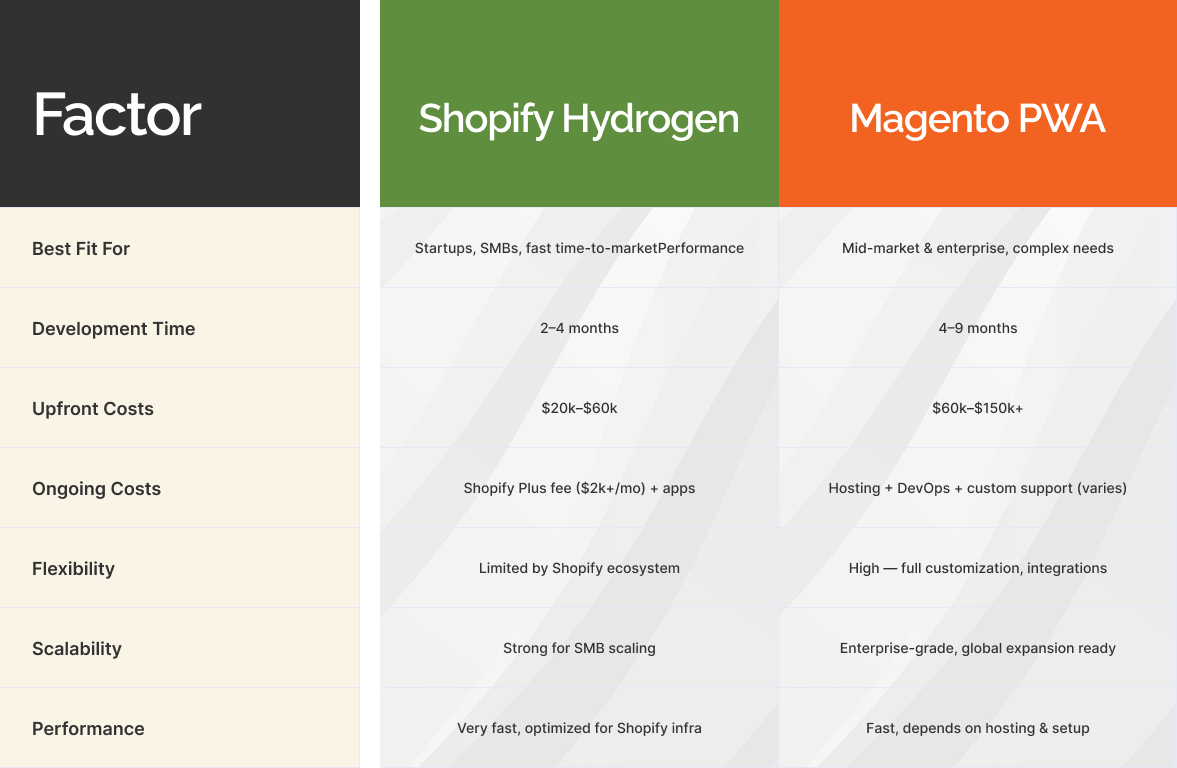
| Metric | Shopify Hydrogen | Magento PWA (Adobe Commerce) |
|---|---|---|
| Model | Hosted / SaaS-friendly | Self-hosted / enterprise |
| Time to launch | Fast (weeks → months) | Longer (months → quarters) |
| Best fit | DTC, SMBs, fast launches | Enterprise, B2B, complex catalogues |
| Dev skillset | React/Remix + Shopify APIs | React + Magento (GraphQL, PHP expertise) |
| Maintenance | Lower (managed options) | Higher (hosting + ops) |
| Cost pattern | Upfront dev + subscription | Upfront dev + hosting + license |
| Flexibility | High within Shopify limits | Very high (full control) |
Bottom line for business owners: Choose Hydrogen if you want speed and less operational overhead. Pick Magento PWA when you need deep customisation, B2B features or multi-store control that Shopify can’t natively deliver.
For additional insights into Shopify’s headless commerce solutions, this Shopify headless commerce resource explains the practical applications for modern storefronts.
Why Move to Headless Now? (Business drivers)

- Customer expectations — Mobile-first and app-like experiences are table stakes. Slow pages drive abandonment.
- Omnichannel expansion — One backend powering web, mobile PWA, kiosks and voice reduces duplication.
- Faster experimentation — Marketing teams can try new experiences without backend changes.
- Performance gains → conversion lifts — Even modest speed improvements often produce significant uplifts in conversion and AOV.
- Future integration — AI recommendations, AR try-ons, and voice commerce are easier to adopt with a headless, API-first architecture.
If your store is losing traffic or struggling under peak demand, headless is a growth and risk-management strategy, not just a tech fad.
Headless Commerce Migration Checklist (Step by Step)
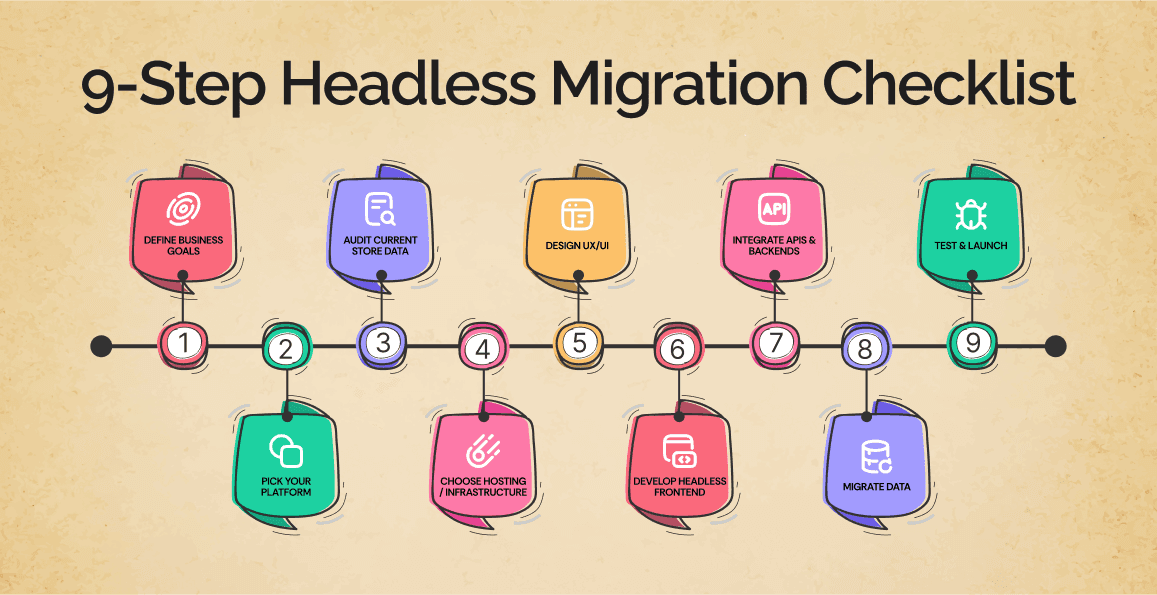
1. Define goals & metrics
Document why you’re doing this and what success looks like (e.g., +20% mobile conversion, 30% faster LCP).
2. Audit current systems
Inventory products, integrations, traffic patterns, SEO-critical pages and analytics. Note any custom checkout or B2B logic.
3. Choose platform & strategy
Decide Hydrogen vs Magento PWA based on needs (speed vs complexity). Choose phased migration or big-bang.
4. Plan SEO & URL mapping
Map existing URLs and metadata so 301 redirects keep search equity. Preserve key landing pages and canonical rules.
5. Prepare data & integrations
Plan exports (products, customers, orders). List essential integrations (ERP, CRM, payment gateways, fulfillment).
6. Build frontend & connect APIs
Develop the new frontend (React/PWA) and test API endpoints — product, cart, checkout, customer.
7. QA: functional + performance + SEO
Test all customer journeys, run load tests and validate Core Web Vitals. Verify redirects and structured data.
8. Launch & monitor
Switch during low-traffic windows. Monitor errors, 404s and conversion metrics closely in the first weeks. Keep a rollback plan.
9. Optimize continuously
Iterate on UX, personalise with AI tools, and maintain the backend integrations.
We’ve created a handy Headless Commerce Migration Checklist PDF you can download to plan and track your migration step by step.
Download Now
Cost & ROI — Realistic Ranges (Business View)
Upfront Development Costs (Estimated Ranges)
- Small/SMB Hydrogen project: $20k–$60k
- Mid-market Hydrogen or smaller Magento PWA: $60k–$150k
- Enterprise Magento PWA: $150k+ (complex integrations, multi-market)
Ongoing costs (Estimated Ranges)
- Shopify Plus + apps: platform fee ($2k+/mo) + app subscriptions.
- Magento: hosting, licences, DevOps and support (variable; can be tens of thousands/yr for enterprise).
ROI drivers
- Faster pages → higher conversions (+10–30% typical uplift reported).
- Better mobile UX → increased mobile revenue share.
- Faster releases → more marketing experiments and faster wins.
Payback timeframe
- Many merchants aim to recoup costs in 6–18 months, depending on traffic and AOV. Model conservatively: smaller merchants often see quicker paybacks; enterprise projects may take longer but scale further.
Case Studies: How AALogics Helped Brands Go Headless
RafRaf (Saudi Arabia) — Migrated to a headless React frontend on Magento, deployed via Vercel with GraphQL APIs.
Outcome: Near-zero downtime, faster load times, and stability during traffic spikes.
Result: Reliable scaling for Saudi Arabia’s growing auto parts eCommerce market.
Richy’s Store (Saudi Arabia) — Migrated to a headless PWA on Magento (GraphCommerce + AWS auto-scaling).
Outcome: Faster load times, Arabic support and reliable performance during sales spikes.
Result: Improved mobile engagement and fewer outages.
iMarkPlace (multi-vendor marketplace) — Implemented a Magento PWA overlay turning the mobile site into an app-like experience.
Outcome: Higher engagement and faster perceived load times without forcing native app downloads.
Result: Improved user retention and a smoother mobile shopping journey with lower development overhead.
Zero Makeup (Pakistan) — Migrated from Magento to Shopify (non-headless, Shopify custom theme for simplicity).
Outcome: Much lower maintenance, faster site, and stable checkout — ideal for a mid-market brand wanting lower ops overhead.
Result: Reduced operational costs and richer customer experience with minimal downtime and consistent performance.
These examples show different roads to better UX: headless PWA for complex scale, and Shopify-based rebuilds for operational simplicity. AALogics matches the technical approach to the business goal.
Common pitfalls & how to avoid them
- Skipping SEO planning: Always map URLs and keep redirects. Test search-critical pages pre/post-launch.
- Underestimating integrations: Many plugins and extensions don’t migrate straight across — plan custom endpoints and middleware.
- Insufficient testing: Load testing and Core Web Vitals checks need to be baked into your QA.
- Over-customisation: Prioritise conversion-driving features; avoid bloat.
- Lack of training: Train editors and marketers on new CMS previews/workflows.
Why AALogics Is the Right Partner for Your Headless Commerce Migration
AALogics provides end-to-end support:
- Strategy workshops and business-aligned scoping.
- Full frontend development (Hydrogen or PWA) plus API integrations.
- SEO-safe migrations (301 mapping, content preservation).
- Post-launch monitoring, optimisation and ongoing support.
Future-Proofing Tips (Short List)
- Adopt modular microservices to swap best-of-breed tools quickly.
- Use structured data and short FAQ answers for voice/AEO.
- Track Core Web Vitals and prioritise LCP/CLS improvements.
- Pilot AI personalization on a few pages before rolling out site-wide.
Conclusion
Headless commerce in 2025 is a practical, often high-ROI strategy for brands that need speed, omnichannel reach and faster iteration. Shopify Hydrogen delivers quick wins and lower operational complexity for DTC and SMBs. Magento PWA benefits enterprises that require deep customisation and B2B functionality.
If your growth is limited by page speed, checkout friction or a desire to deliver omnichannel experiences, a planned headless migration — scoped to business goals — can be a transformational investment.
Ready to make your store faster and smarter?
Frequently Asked Questions
What is headless commerce?
Headless commerce separates the frontend from the backend so you can build custom storefronts while keeping the same commerce engine. It enables faster pages and omnichannel experiences.
When should I choose Shopify Hydrogen?
Choose Hydrogen if you’re already on Shopify and want a fast, modern frontend with lower ops overhead and faster time to market.
When should I choose Magento PWA?
Choose Magento PWA for enterprise needs: complex catalogues, B2B features, multi-store and deep customisation
How much does migration cost?
Costs vary widely: small projects may be tens of thousands; enterprise headless implementations commonly exceed $150k. Exact cost depends on integrations and scope.
How long does migration take?
Expect weeks for simpler Hydrogen projects and several months for full Magento PWA projects. Mid-market projects often take 3–6 months end-to-end.
Will headless improve SEO?
Yes — when built correctly. Faster pages and improved Core Web Vitals help SEO, but you must plan redirects and structured data to preserve rankings.
Why choose AALogics?
AALogics offers end-to-end experience across Shopify and Magento headless projects, with a focus on business outcomes: speed, conversions and maintainability.
Featured Articles
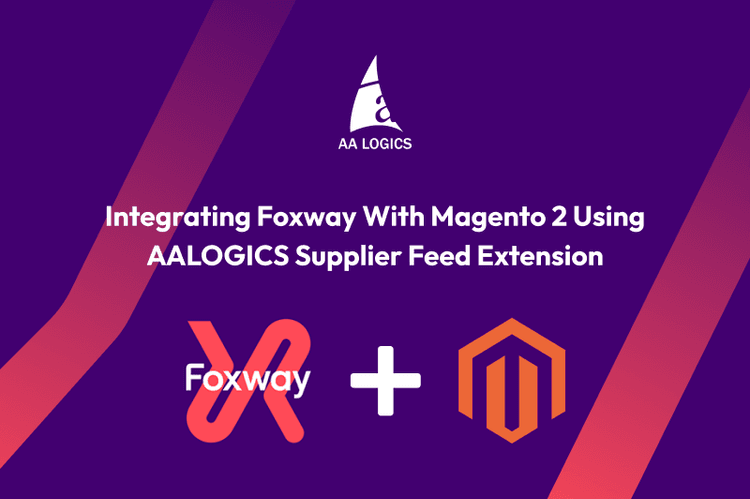
Magento 2 Product Import Guide: Integrating Foxway with Magento 2 Using AALOGICS Supplier Feed Extension
Read More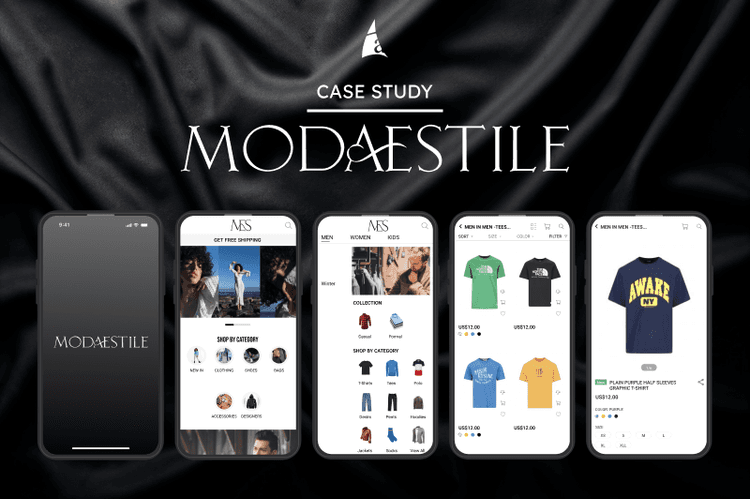
How Modaestile Launched a Fully Functional Mobile App in Record Time — Without Expensive Custom Development
Read More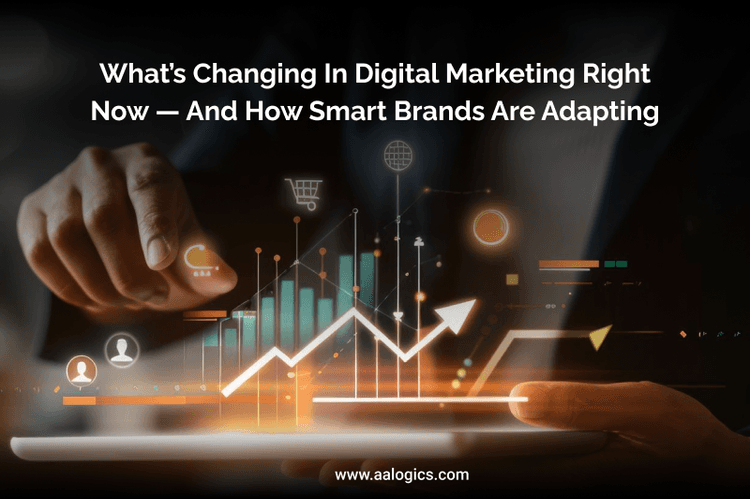
What’s Changing in Digital Marketing Right Now — And How Smart Brands Are Adapting
Read More
How Riazone Transformed Its Slow Magento Storefront Into a Lightning-Fast Graph Commerce Experience — In Record Time
Read More